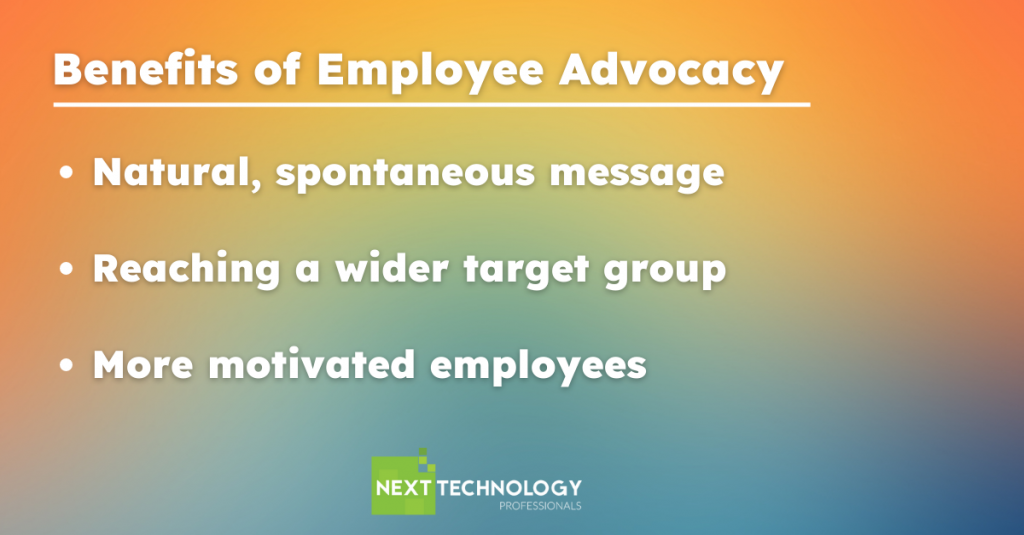Oftentimes, when we plan brand-building activities, we first think of outsiders who have experience in this type of promotion, e.g. social media influencers. While they can be very helpful in spreading positive information about the company and its products or services, remember that the best brand ambassadors will always be your employees. Why?
Because they know the company best and can give the communication a unique character. They know what works in the company and what is worth showing off outside in order to attract the best talents to it. Employees are one of the most reliable sources of information for applicants. They present the reality in which they operate themselves, and the candidates believe their stories because they are authentic.
In this article you will learn:
- what Employee Advocacy is,
- what the benefits of the program are,
- how to prepare employees for its implementation,
- what mistakes to avoid when engaging employees in building the company’s image.
What is Employee Advocacy?
Employee Advocacy is a combination of two components: employer branding, which consists of building the employer’s brand and personal branding, i.e. creating a personal brand by managing your image, most often presenting a given person as a professional specialist or expert.
Employee Advocacy is nothing more than inviting employees to promote the company. This can be done in various ways. Promoting a brand in the simplest terms is sharing positive comments about the company with friends and family or using company gadgets with the company’s logo, such as sweatshirts, stickers on the laptop cover, mugs, etc.
A more advanced form of engaging employees in branding activities is through participating in networking events and publishing encouraging content on social media. These can be well-thought-out, strategically planned posts as well as spontaneous workplace videos showing a friendly atmosphere in a team or interesting opportunities to spend free time in the office.
How to prepare employees for the implementation of the Employee Advocacy program?
The main goal of promotional activities involving employees is to provide information and engage the desired group of recipients, e.g. future employees or clients, as well as educate and attract potential employees.
When planning an Employee Advocacy strategy, we must remember to provide support to the ambassadors. It is very important that their efforts are appreciated by the company’s management, e.g. in the form of additional bonuses or prizes for the most active ambassadors. Another of the key motivators to participate in the program is the opportunity to develop new skills. Before we start implementing the actions, let’s prepare the employees well for this role. The support they will need from us will primarily include training in:
- techniques to strengthen the message when promoting the company,
- storytelling and the ability to talk about your experiences “from the inside”,
- ways to build audience engagement,
- building your image as an expert in a given field.
Benefits of Employee Advocacy
Employee Advocacy activities bring many benefits to both employers and employees involved in promoting the company.

Natural, spontaneous message
The content posted by individual employees is much more powerful than the messages of an impersonal brand. Their message is simply more natural, often spontaneous, and this human-generated content includes emotions that engage with the recipients and motivate them to interact with the sender of the message. Posts created by the specific social media users carry a credible message, show the perspective of a given person who has needs, desires and goals that others can identify with.
Reaching a wider target group
Our employees are able to look at the company in a human way and share their insights with an extensive network of contacts to which we, as a company, often do not have access. All this translates into greater interest from our target group, and hence, increasing the audience reach.
More motivated employees
Thanks to this type of promotional activities, we gain more satisfied and engaged employees. If we conduct the Employee Advocacy program well, employees will appreciate the opportunity to build their brands and show themselves as experts in social media. They will be able to develop in the field of promotion and marketing, praise their achievements among friends from the industry and build their identification with the brand. They will feel important to the company. They will be able to share their thoughts and experiences through posts, articles and speeches.
Thanks to this, not only employees will develop their skills, but also present the company as a place for growth, which in turn will translate into greater interest in working in the enterprise among people observing their activity in the media, i.e. potential job candidates.
What mistakes to avoid when implementing Employee Advocacy?
Employee Advocacy brings a number of benefits. However, its planning and implementation in the company is not easy. Especially if we are doing it for the first time and we do not have extensive experience in planning image-building activities. Many companies make serious mistakes which, instead of encouraging new candidates to apply, only spoil the employer’s brand, while negatively affecting the motivation of employees involved in these activities.
What should we be most careful about?
Excessive persuasion of employees to share content about the company
Remember that the Employee Advocacy program should only include those people who want to take part in it. You can sometimes encourage employees to share specific information or news on social media. However, if an employee is reluctant to publish information about their employment, do not identify this as evidence of a bad attitude. Also, don’t encourage anyone to share your company posts and announcements. This will be counterproductive. The forced content will not be authentic and the employee will feel manipulated.
Implementing the program in a company with a low level of job satisfaction
Employees will be reluctant to promote a company if they themselves are not satisfied with working in it. Therefore, before starting activities and searching for brand ambassadors, check the employee satisfaction level and what they think about the company as an employer. By using an anonymous survey, you will increase the chances of getting honest answers. With it, you can also immediately ask employees if they would be interested in introducing Employee Advocacy activities in your company.
No action plan and description of needed resources
Before implementing each image-building activity, we should carefully plan the entire process. A properly conducted Employee Advocacy program requires precise determination of resources, setting goals and planning milestones. For its implementation, it is necessary to specify the time in which the program will be conducted and the date of its completion. Let’s also take care of the prior preparation of materials that we will use before and during it (the content of messages, graphics, video materials). Before implementing the activities, we should conduct training for brand ambassadors, prepare a set of guidelines and provide them with appropriate support.
If you are looking for engaged IT specialists to join your company – contact us, we will help you find and hire them.




